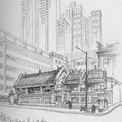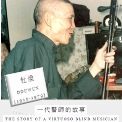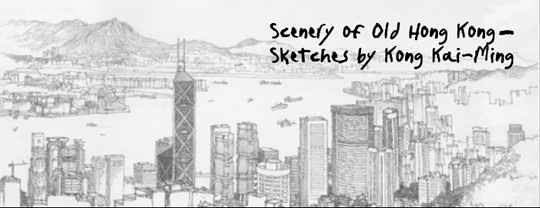Gengshen Diaowei (Farming and Fishing)
This piece was included in a manuscript from the late Qing Dynasty. It is a very short piece that conveys a quiet mood. This recording is played based on Yinyinshi Qinpu (Yinyinshi Manuscript) (2000) of Tsar Teh-yun and is played by Kwok Kang-ming, Eric with his own made Haozhong Style Qin (silk strings).| Date | 2013 |
| Maker's Note | This is the second qin I made during my apprenticeship with Master Choi Chang-sau. Except for the base cement, I deliberately replaced the traditional antler powder with cinnabar at various stages. My daughter, who had begun learning calligraphy at the time, was invited to write down the year and month of the making of the qin inside the “dragon pond.” |
| People | Kwok Kang-ming, Eric |
| Material Type | Audio |
| Collection | The Legend of Silk and Wood: A Hong Kong Qin Story |
| Source | Intangible Cultural Heritage Office and Hong Kong Heritage Museum |
| Repository | Intangible Cultural Heritage Office |
| Note to Copyright | Permission for use in Hong Kong Memory is given by Intangible Cultural Heritage Office and Hong Kong Heritage Museum |
| Accession No. | lcs-hkqs-0225 |


Wuye Wu Qiufeng (Parasol Leaves Dancing in the Autumn Breeze)
This piece first appeared in the Qinxue Xinsheng (Study and Aspirations of the Qin) (1664) by Zhuang Zhenfung of the Qing Dynasty and is the most widely played piece among the composer’s fourteen works. It has a delicate melody which evocatively describes the sound of falling leaves in an autumn breeze. In this performance, the piece is played based on Qing Rui's heirloom manuscripts and is played by Yung Hak-chi, Hammond with his own made Keng'er Qin (metal strings).


Yangguan Sandie (Parting at Yangguan)
The earliest version of this piece of qin music appeared in the Zheyin Shizi Qinpu (Qin Songs in Zhejiang Dialect) (1491). The lyrics were developed from a famous poem by the Tang poet, Wang Wei, titled Song Yuan’er Shi Anxi (Seeing Yuan Er Off as Commissioner to Anxi). Many other versions appeared later, but these were either shortened or extended as the arrangers or musicians saw fit. This version is derived from the Yinyinshi Qinpu (Yinyinshi Manuscript) (2000) of Tsar Teh-yun. The music opens slowly, and then accelerates. As the emotions escalate, it changes to rubato before it comes to a more relaxed and muted closing, ending on harmonic notes. The undulating melodic line attempts to recreate the changing emotions of dear friends at parting. This recording is played by Ng Ying-wai with her own made Songtao Qin (synthetic fibre strings).


Pingsha Luoyan (Wild Geese Landing on Sand)
This piece first appeared in a manuscript of the late Ming Dynasty. One of the most widely played pieces of the last three hundred years, it exists in scores of notational versions. The version in the Tianwenge Qinpu (Tianwenge Qin Handbook) (1876) bears a note that suggests programmatic content: “The autumnal sky is high and the air is clear; the wind is calm and the sand is smooth; the clouds stretch for ten thousand miles; the wild geese fly freely in the sky, sharing the thoughts of this wanderer.” This recording is played based on Jiao’an Qinpu (Jiao’an Qin Handbook) (1868) and is played by Siu Yat-tung with his own made Zhongni Style Qin (silk strings).
Gengshen Diaowei (Farming and Fishing)
This piece was included in a manuscript from the late Qing Dynasty. It is a very short piece that conveys a quiet mood. This recording is played based on Yinyinshi Qinpu (Yinyinshi Manuscript) (2000) of Tsar Teh-yun and is played by Kwok Kang-ming, Eric with his own made Haozhong Style Qin (silk strings).| Date | 2013 |
| Material Type | Audio |
| People | Kwok Kang-ming, Eric |
| Collection | The Legend of Silk and Wood: A Hong Kong Qin Story |
| Source | Intangible Cultural Heritage Office and Hong Kong Heritage Museum |
| Repository | Intangible Cultural Heritage Office |
| Note to Copyright | Permission for use in Hong Kong Memory is given by Intangible Cultural Heritage Office and Hong Kong Heritage Museum |
| Accession No. | lcs-hkqs-0225 |


Wuye Wu Qiufeng (Parasol Leaves Dancing in the Autumn Breeze)
This piece first appeared in the Qinxue Xinsheng (Study and Aspirations of the Qin) (1664) by Zhuang Zhenfung of the Qing Dynasty and is the most widely played piece among the composer’s fourteen works. It has a delicate melody which evocatively describes the sound of falling leaves in an autumn breeze. In this performance, the piece is played based on Qing Rui's heirloom manuscripts and is played by Yung Hak-chi, Hammond with his own made Keng'er Qin (metal strings).


Yangguan Sandie (Parting at Yangguan)
The earliest version of this piece of qin music appeared in the Zheyin Shizi Qinpu (Qin Songs in Zhejiang Dialect) (1491). The lyrics were developed from a famous poem by the Tang poet, Wang Wei, titled Song Yuan’er Shi Anxi (Seeing Yuan Er Off as Commissioner to Anxi). Many other versions appeared later, but these were either shortened or extended as the arrangers or musicians saw fit. This version is derived from the Yinyinshi Qinpu (Yinyinshi Manuscript) (2000) of Tsar Teh-yun. The music opens slowly, and then accelerates. As the emotions escalate, it changes to rubato before it comes to a more relaxed and muted closing, ending on harmonic notes. The undulating melodic line attempts to recreate the changing emotions of dear friends at parting. This recording is played by Ng Ying-wai with her own made Songtao Qin (synthetic fibre strings).


Pingsha Luoyan (Wild Geese Landing on Sand)
This piece first appeared in a manuscript of the late Ming Dynasty. One of the most widely played pieces of the last three hundred years, it exists in scores of notational versions. The version in the Tianwenge Qinpu (Tianwenge Qin Handbook) (1876) bears a note that suggests programmatic content: “The autumnal sky is high and the air is clear; the wind is calm and the sand is smooth; the clouds stretch for ten thousand miles; the wild geese fly freely in the sky, sharing the thoughts of this wanderer.” This recording is played based on Jiao’an Qinpu (Jiao’an Qin Handbook) (1868) and is played by Siu Yat-tung with his own made Zhongni Style Qin (silk strings).
Gengshen Diaowei (Farming and Fishing)
This piece was included in a manuscript from the late Qing Dynasty. It is a very short piece that conveys a quiet mood. This recording is played based on Yinyinshi Qinpu (Yinyinshi Manuscript) (2000) of Tsar Teh-yun and is played by Kwok Kang-ming, Eric with his own made Haozhong Style Qin (silk strings).| Date | 2013 |
| People | Kwok Kang-ming, Eric |
| Material Type | Audio |
| Collection | The Legend of Silk and Wood: A Hong Kong Qin Story |
| Source | Intangible Cultural Heritage Office and Hong Kong Heritage Museum |
| Repository | Intangible Cultural Heritage Office |
| Note to Copyright | Permission for use in Hong Kong Memory is given by Intangible Cultural Heritage Office and Hong Kong Heritage Museum |
| Accession No. | lcs-hkqs-0225 |


Wuye Wu Qiufeng (Parasol Leaves Dancing in the Autumn Breeze)
This piece first appeared in the Qinxue Xinsheng (Study and Aspirations of the Qin) (1664) by Zhuang Zhenfung of the Qing Dynasty and is the most widely played piece among the composer’s fourteen works. It has a delicate melody which evocatively describes the sound of falling leaves in an autumn breeze. In this performance, the piece is played based on Qing Rui's heirloom manuscripts and is played by Yung Hak-chi, Hammond with his own made Keng'er Qin (metal strings).


Yangguan Sandie (Parting at Yangguan)
The earliest version of this piece of qin music appeared in the Zheyin Shizi Qinpu (Qin Songs in Zhejiang Dialect) (1491). The lyrics were developed from a famous poem by the Tang poet, Wang Wei, titled Song Yuan’er Shi Anxi (Seeing Yuan Er Off as Commissioner to Anxi). Many other versions appeared later, but these were either shortened or extended as the arrangers or musicians saw fit. This version is derived from the Yinyinshi Qinpu (Yinyinshi Manuscript) (2000) of Tsar Teh-yun. The music opens slowly, and then accelerates. As the emotions escalate, it changes to rubato before it comes to a more relaxed and muted closing, ending on harmonic notes. The undulating melodic line attempts to recreate the changing emotions of dear friends at parting. This recording is played by Ng Ying-wai with her own made Songtao Qin (synthetic fibre strings).


Pingsha Luoyan (Wild Geese Landing on Sand)
This piece first appeared in a manuscript of the late Ming Dynasty. One of the most widely played pieces of the last three hundred years, it exists in scores of notational versions. The version in the Tianwenge Qinpu (Tianwenge Qin Handbook) (1876) bears a note that suggests programmatic content: “The autumnal sky is high and the air is clear; the wind is calm and the sand is smooth; the clouds stretch for ten thousand miles; the wild geese fly freely in the sky, sharing the thoughts of this wanderer.” This recording is played based on Jiao’an Qinpu (Jiao’an Qin Handbook) (1868) and is played by Siu Yat-tung with his own made Zhongni Style Qin (silk strings).
Gengshen Diaowei (Farming and Fishing)
This piece was included in a manuscript from the late Qing Dynasty. It is a very short piece that conveys a quiet mood. This recording is played based on Yinyinshi Qinpu (Yinyinshi Manuscript) (2000) of Tsar Teh-yun and is played by Kwok Kang-ming, Eric with his own made Haozhong Style Qin (silk strings).| Interview Date | Date | 2013 |
| People | Kwok Kang-ming, Eric | |
| Material Type | Audio | |
| Collection | The Legend of Silk and Wood: A Hong Kong Qin Story | |
| Source | Intangible Cultural Heritage Office and Hong Kong Heritage Museum | |
| Repository | Intangible Cultural Heritage Office | |
| Note to Copyright | Permission for use in Hong Kong Memory is given by Intangible Cultural Heritage Office and Hong Kong Heritage Museum | |
| Accession No. | lcs-hkqs-0225 |


Wuye Wu Qiufeng (Parasol Leaves Dancing in the Autumn Breeze)
This piece first appeared in the Qinxue Xinsheng (Study and Aspirations of the Qin) (1664) by Zhuang Zhenfung of the Qing Dynasty and is the most widely played piece among the composer’s fourteen works. It has a delicate melody which evocatively describes the sound of falling leaves in an autumn breeze. In this performance, the piece is played based on Qing Rui's heirloom manuscripts and is played by Yung Hak-chi, Hammond with his own made Keng'er Qin (metal strings).


Yangguan Sandie (Parting at Yangguan)
The earliest version of this piece of qin music appeared in the Zheyin Shizi Qinpu (Qin Songs in Zhejiang Dialect) (1491). The lyrics were developed from a famous poem by the Tang poet, Wang Wei, titled Song Yuan’er Shi Anxi (Seeing Yuan Er Off as Commissioner to Anxi). Many other versions appeared later, but these were either shortened or extended as the arrangers or musicians saw fit. This version is derived from the Yinyinshi Qinpu (Yinyinshi Manuscript) (2000) of Tsar Teh-yun. The music opens slowly, and then accelerates. As the emotions escalate, it changes to rubato before it comes to a more relaxed and muted closing, ending on harmonic notes. The undulating melodic line attempts to recreate the changing emotions of dear friends at parting. This recording is played by Ng Ying-wai with her own made Songtao Qin (synthetic fibre strings).


Pingsha Luoyan (Wild Geese Landing on Sand)
This piece first appeared in a manuscript of the late Ming Dynasty. One of the most widely played pieces of the last three hundred years, it exists in scores of notational versions. The version in the Tianwenge Qinpu (Tianwenge Qin Handbook) (1876) bears a note that suggests programmatic content: “The autumnal sky is high and the air is clear; the wind is calm and the sand is smooth; the clouds stretch for ten thousand miles; the wild geese fly freely in the sky, sharing the thoughts of this wanderer.” This recording is played based on Jiao’an Qinpu (Jiao’an Qin Handbook) (1868) and is played by Siu Yat-tung with his own made Zhongni Style Qin (silk strings).
Gengshen Diaowei (Farming and Fishing)
This piece was included in a manuscript from the late Qing Dynasty. It is a very short piece that conveys a quiet mood. This recording is played based on Yinyinshi Qinpu (Yinyinshi Manuscript) (2000) of Tsar Teh-yun and is played by Kwok Kang-ming, Eric with his own made Haozhong Style Qin (silk strings).| Interviewee | Kwok Kang-ming, Eric |
| Date | 2013 |
| Material Type | Audio |
| Collection | The Legend of Silk and Wood: A Hong Kong Qin Story |
| Source | Intangible Cultural Heritage Office and Hong Kong Heritage Museum |
| Repository | Intangible Cultural Heritage Office |
| Note to Copyright | Permission for use in Hong Kong Memory is given by Intangible Cultural Heritage Office and Hong Kong Heritage Museum |
| Accession No. | lcs-hkqs-0225 |


Wuye Wu Qiufeng (Parasol Leaves Dancing in the Autumn Breeze)
This piece first appeared in the Qinxue Xinsheng (Study and Aspirations of the Qin) (1664) by Zhuang Zhenfung of the Qing Dynasty and is the most widely played piece among the composer’s fourteen works. It has a delicate melody which evocatively describes the sound of falling leaves in an autumn breeze. In this performance, the piece is played based on Qing Rui's heirloom manuscripts and is played by Yung Hak-chi, Hammond with his own made Keng'er Qin (metal strings).


Yangguan Sandie (Parting at Yangguan)
The earliest version of this piece of qin music appeared in the Zheyin Shizi Qinpu (Qin Songs in Zhejiang Dialect) (1491). The lyrics were developed from a famous poem by the Tang poet, Wang Wei, titled Song Yuan’er Shi Anxi (Seeing Yuan Er Off as Commissioner to Anxi). Many other versions appeared later, but these were either shortened or extended as the arrangers or musicians saw fit. This version is derived from the Yinyinshi Qinpu (Yinyinshi Manuscript) (2000) of Tsar Teh-yun. The music opens slowly, and then accelerates. As the emotions escalate, it changes to rubato before it comes to a more relaxed and muted closing, ending on harmonic notes. The undulating melodic line attempts to recreate the changing emotions of dear friends at parting. This recording is played by Ng Ying-wai with her own made Songtao Qin (synthetic fibre strings).


Pingsha Luoyan (Wild Geese Landing on Sand)
This piece first appeared in a manuscript of the late Ming Dynasty. One of the most widely played pieces of the last three hundred years, it exists in scores of notational versions. The version in the Tianwenge Qinpu (Tianwenge Qin Handbook) (1876) bears a note that suggests programmatic content: “The autumnal sky is high and the air is clear; the wind is calm and the sand is smooth; the clouds stretch for ten thousand miles; the wild geese fly freely in the sky, sharing the thoughts of this wanderer.” This recording is played based on Jiao’an Qinpu (Jiao’an Qin Handbook) (1868) and is played by Siu Yat-tung with his own made Zhongni Style Qin (silk strings).








